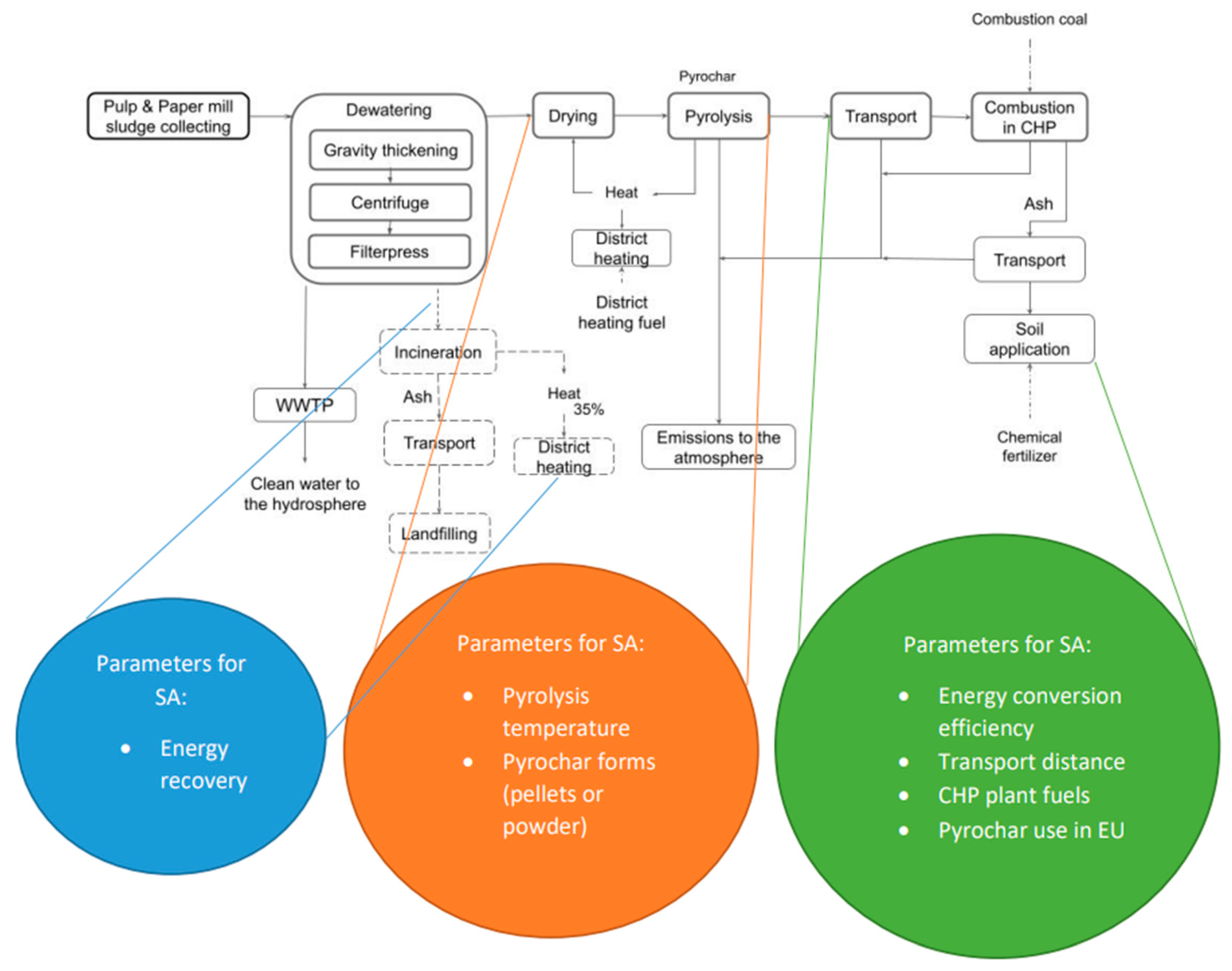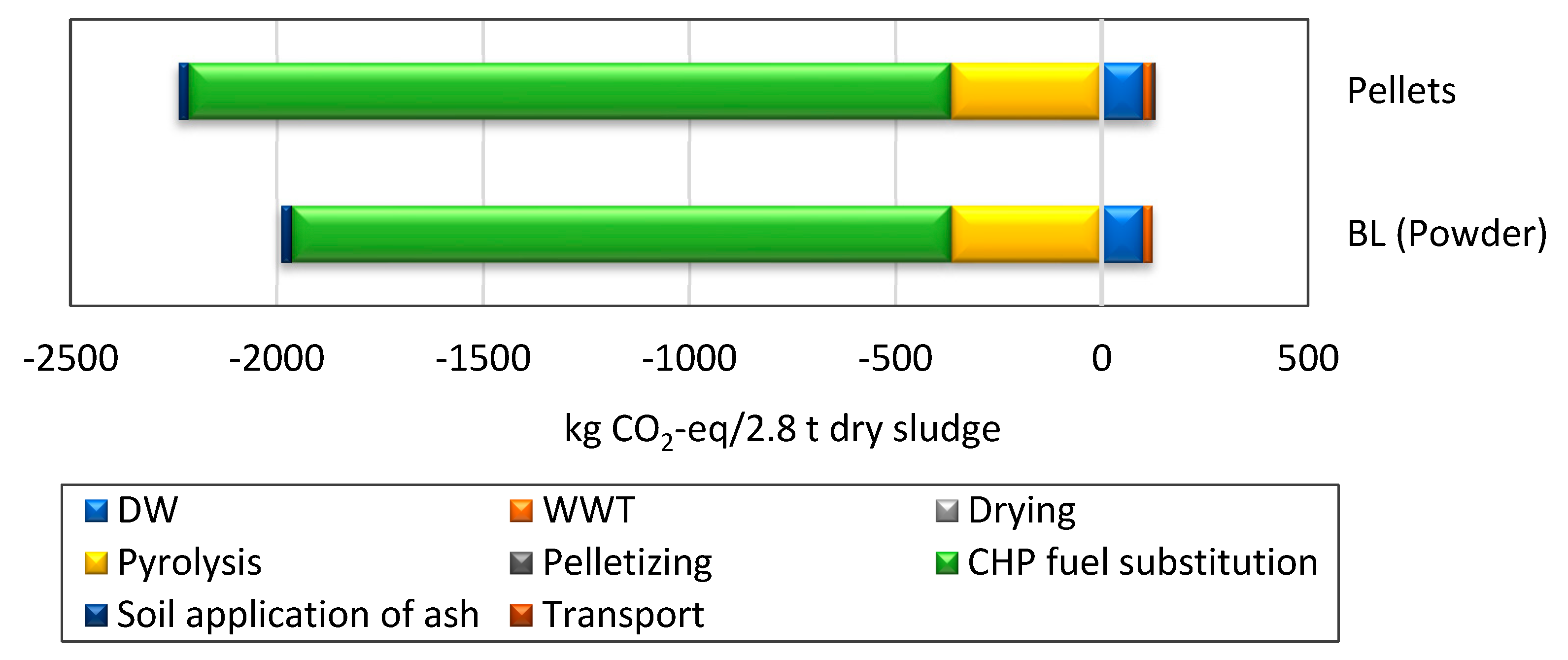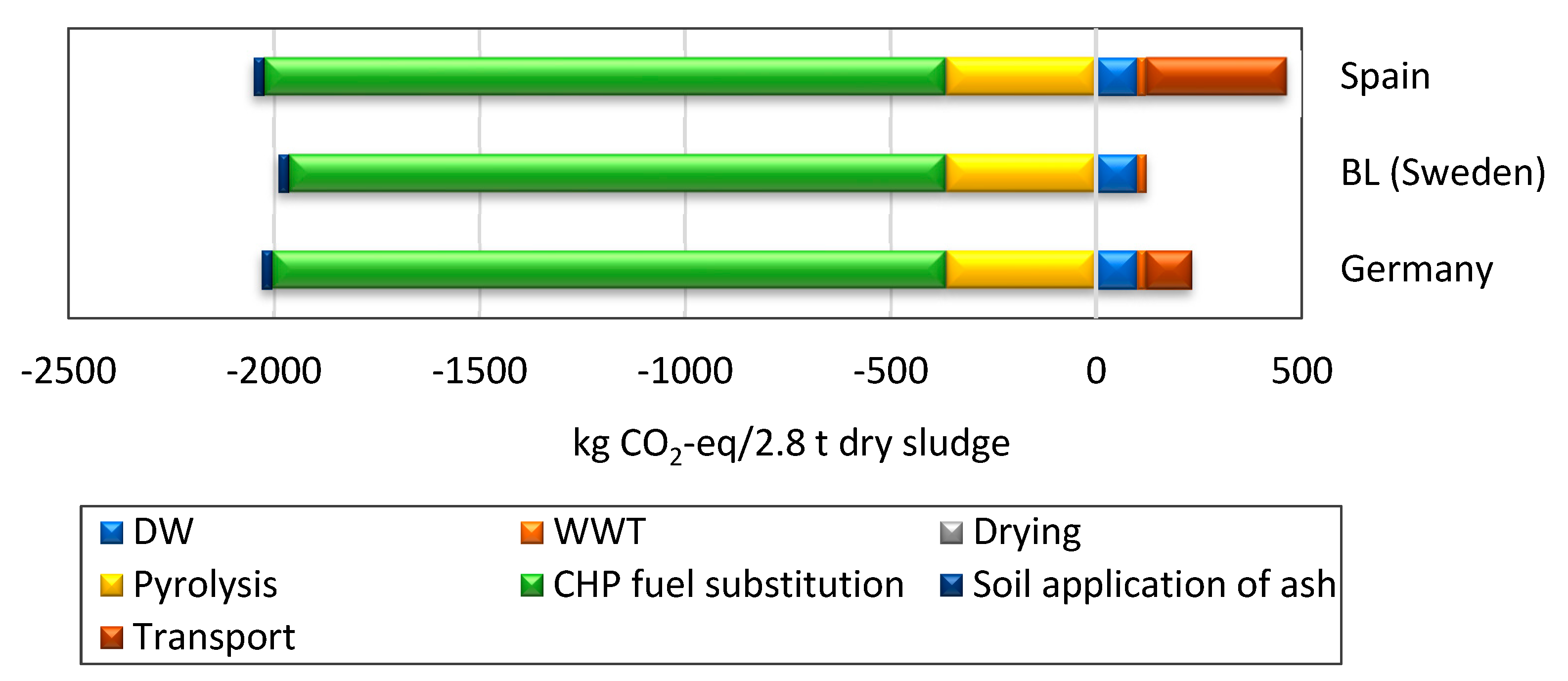Sensitivity Analysis of the Climate Effect of Using Pyrochar Biofuel for Heat and Electricity Generation
Abstract
:1. Introduction
2. Materials and Methods
2.1. Goal and Scope Definition
2.2. System Boundaries and Scenarios
2.2.1. Reference Scenario (RS)
2.2.2. Pyrochar Scenario (PS)
2.3. Material Flow Analysis
2.4. Inventory Analysis
2.5. Assessment
2.6. Sensitivity Analysis
2.6.1. Incineration
2.6.2. Pyrolysis
2.6.3. CHP Process
2.6.4. Location of CHP Plant (Geographical Sensitivity)
2.6.5. Impact Assessment Method
3. Results and Discussion
3.1. Material and Energy Flow Analysis
3.2. Climate Change Impact
3.3. Contribution Analysis
3.4. Sensitivity Analysis
3.5. Implementation of Pyrochar Systems
4. Conclusions
- -
- Application of E-LCA to comparatively analyse different CHP technologies with various energy conversion efficiencies.
- -
- This E-LCA study modelled a specific pyrolysis unit. Other E-LCAs can be applied to study other carbonization technologies like slow pyrolysis, fast pyrolysis and gasification, at different scales, factoring in the differences in the yield and quality of the pyrochar output as well as that of the pyrolysis gases which find use as a source of heat energy.
- -
- As pelletized pyrochar clearly is preferable to the powdered form, optimisation of pelletization techniques from economic, environmental and functional perspectives will be a topic of interest for researchers.
- -
- A thorough economic assessment of pyrochar production technologies, from cradle to end-use (including the cost savings associated with avoided processes), will be a very useful decision-making aid.
Supplementary Materials
Author Contributions
Funding
Institutional Review Board Statement
Informed Consent Statement
Data Availability Statement
Acknowledgments
Conflicts of Interest
Abbreviation
| BL | Baseline |
| CHP | Combined heat and power |
| DM | Dry matter |
| DW | Dewatering |
| E-LCA | Environmental life cycle assessment |
| FU | Functional unit |
| GHG | Greenhouse gas |
| HTC | Hydrothermal carbonization |
| MC | Moisture content |
| MFA | Material flow analysis |
| PS | Pyrochar scenario |
| RS | Reference scenario |
| SA | Sensitivity analysis |
| SI | Supplementary information |
| TC | Transfer coefficient |
| WWTP | Wastewater treatment plant |
References
- Yue, X.-L.; Gao, Q.-X. Contributions of Natural Systems and Human Activity to Greenhouse Gas Emissions. Adv. Clim. Chang. Res. 2018, 9, 243–252. [Google Scholar] [CrossRef]
- Eriksson, O.; Finnveden, G.; Ekvall, T.; Björklund, A. Life Cycle Assessment of Fuels for District Heating: A Comparison of Waste Incineration, Biomass- and Natural Gas Combustion. Energy Policy 2007, 35, 1346–1362. [Google Scholar] [CrossRef]
- Karlsson, J.; Brunzell, L.; Venkatesh, G. Material-Flow Analysis, Energy Analysis, and Partial Environmental-LCA of a District-Heating Combined Heat and Power Plant in Sweden. Energy 2018, 144, 31–40. [Google Scholar] [CrossRef]
- Persson, U.; Münster, M. Current and Future Prospects for Heat Recovery from Waste in European District Heating Systems: A Literature and Data Review. Energy 2016, 110, 116–128. [Google Scholar] [CrossRef] [Green Version]
- Swedish Energy Agency. Available online: http://www.energimyndigheten.se/en/ (accessed on 12 May 2021).
- Urbancl, D.; Zlak, J.; Anicic, B.; Trop, P.; Goricanec, D. The Evaluation of Heat Production Using Municipal Biomass Co-Incineration within a Thermal Power Plant. Energy 2016, 108, 140–147. [Google Scholar] [CrossRef]
- Lee, M.; Lin, Y.-L.; Chiueh, P.-T.; Den, W. Environmental and Energy Assessment of Biomass Residues to Biochar as Fuel: A Brief Review with Recommendations for Future Bioenergy Systems. J. Clean. Prod. 2020, 251, 119714. [Google Scholar] [CrossRef]
- Chi, N.T.L.; Anto, S.; Ahamed, T.S.; Kumar, S.S.; Shanmugam, S.; Samuel, M.S.; Mathimani, T.; Brindhadevi, K.; Pugazhendhi, A. A Review on Biochar Production Techniques and Biochar Based Catalyst for Biofuel Production from Algae. Fuel 2021, 287, 119411. [Google Scholar] [CrossRef]
- Fernández-González, R.; Martín-Lara, M.A.; Moreno, J.A.; Blázquez, G.; Calero, M. Effective Removal of Zinc from Industrial Plating Wastewater Using Hydrolyzed Olive Cake: Scale-up and Preparation of Zinc-Based Biochar. J. Clean. Prod. 2019, 227, 634–644. [Google Scholar] [CrossRef]
- Rizwan, M.; Ali, S.; Qayyum, M.F.; Ibrahim, M.; Zia-ur-Rehman, M.; Abbas, T.; Ok, Y.S. Mechanisms of Biochar-Mediated Alleviation of Toxicity of Trace Elements in Plants: A Critical Review. Environ. Sci. Pollut. Res. 2016, 23, 2230–2248. [Google Scholar] [CrossRef]
- Mohammadi, A.; Khoshnevisan, B.; Venkatesh, G.; Eskandari, S. A Critical Review on Advancement and Challenges of Biochar Application in Paddy Fields: Environmental and Life Cycle Cost Analysis. Processes 2020, 8, 1275. [Google Scholar] [CrossRef]
- Mohammadi, A.; Cowie, A.; Anh Mai, T.L.; Anaya de la Rosa, R.; Kristiansen, P.; Brandão, M.; Joseph, S. Quantifying the greenhouse gas reduction benefits of utilising straw biochar and enriched biochar. Energy Procedia 2016, 97, 254–261. [Google Scholar] [CrossRef] [Green Version]
- Matuštík, J.; Hnátková, T.; Kočí, V. Life Cycle Assessment of Biochar-to-Soil Systems: A Review. J. Clean. Prod. 2020, 259, 120998. [Google Scholar] [CrossRef]
- Peters, J.F.; Iribarren, D.; Dufour, J. Biomass Pyrolysis for Biochar or Energy Applications? A Life Cycle Assessment. Environ. Sci Technol. 2015, 49, 5195–5202. [Google Scholar] [CrossRef] [PubMed]
- Mohammadi, A.; Sandberg, M.; Venkatesh, G.; Eskandari, S.; Dalgaard, T.; Joseph, S.; Granström, K. Environmental Analysis of Producing Biochar and Energy Recovery from Pulp and Paper Mill Biosludge. J. Ind. Ecol. 2019, 23, 1039–1051. [Google Scholar] [CrossRef]
- Larsen, H.F.; Hansen, P.A.; Boyer-Souchet, F. Deliverable 4.3 Decision Support Guideline Based on LCA and Cost/Efficiency Assessment—DTU Research Database. Available online: https://orbit.dtu.dk/en/publications/deliverable-43-decision-support-guideline-based-on-lca-and-costef (accessed on 12 March 2021).
- Owsianiak, M.; Lindhjem, H.; Cornelissen, G.; Hale, S.E.; Sørmo, E.; Sparrevik, M. Environmental and Economic Impacts of Biochar Production and Agricultural Use in Six Developing and Middle-Income Countries. Sci. Total Environ. 2021, 755, 142455. [Google Scholar] [CrossRef] [PubMed]
- Papageorgiou, A.; Azzi, E.S.; Enell, A.; Sundberg, C. Biochar Produced from Wood Waste for Soil Remediation in Sweden: Carbon Sequestration and Other Environmental Impacts. Sci. Total Environ. 2021, 776, 145953. [Google Scholar] [CrossRef]
- Owsianiak, M.; Cornelissen, G.; Hale, S.E.; Lindhjem, H.; Sparrevik, M. Influence of Spatial Differentiation in Impact Assessment for LCA-Based Decision Support: Implementation of Biochar Technology in Indonesia. J. Clean. Prod. 2018, 200, 259–268. [Google Scholar] [CrossRef]
- Sahoo, K.; Upadhyay, A.; Runge, T.; Bergman, R.; Puettmann, M.; Bilek, E. Life-Cycle Assessment and Techno-Economic Analysis of Biochar Produced from Forest Residues Using Portable Systems. Int. J. Life Cycle Assess 2021, 26, 189–213. [Google Scholar] [CrossRef]
- Mohammadi, A.; Sandberg, M.; Venkatesh, G.; Eskandari, S.; Dalgaard, T.; Joseph, S.; Granström, K. Environmental Performance of End-of-Life Handling Alternatives for Paper-and-Pulp-Mill Sludge: Using Digestate as a Source of Energy or for Biochar Production. Energy 2019, 182, 594–605. [Google Scholar] [CrossRef]
- Swiss Centre for Life Cycle Inventories. Ecoinvent Database v.3.1. Available online: https://www.ecoinvent.org/ (accessed on 1 April 2021).
- Rasa, K.; Pennanen, T.; Peltoniemi, K.; Velmala, S.; Fritze, H.; Kaseva, J.; Joona, J.; Uusitalo, R. Pulp and Paper Mill Sludges Decrease Soil Erodibility. J. Environ. Qual. 2021, 50, 172–184. [Google Scholar] [CrossRef]
- Ahlroth, M.; Bialik, M.; Jensen, A. Hydrothermal Carbonisation of Effluent Sludge; Åforsk Project 15–489; ÅForsk Foundation: Stockholm, Sweden, 2017. [Google Scholar]
- Suh, Y.-J.; Rousseaux, P. An LCA of Alternative Wastewater Sludge Treatment Scenarios. Resour. Conserv. Recycl. 2002, 35, 191–200. [Google Scholar] [CrossRef]
- Pietro, P.; Bidini, G.; Saputo, P.; Fantozzi, F. Biochar Pellet Carbon Footprint. Chem. Eng. Trans. 2016, 50, 217–222. [Google Scholar] [CrossRef]
- Mohammadi, A.; Venkatesh, G.; Sandberg, M.; Eskandari, S.; Joseph, S.; Granström, K. A Comprehensive Environmental Life Cycle Assessment of the Use of Hydrochar Pellets in Combined Heat and Power Plants. Sustainability 2020, 12, 9026. [Google Scholar] [CrossRef]
- Mohammadi, A.; Cowie, A.L.; Anh Mai, T.L.; Brandão, M.; Anaya de la Rosa, R.; Kristiansen, P.; Joseph, S. Climate-Change and Health Effects of Using Rice Husk for Biochar-Compost: Comparing Three Pyrolysis Systems. J. Clean. Prod. 2017, 162, 260–272. [Google Scholar] [CrossRef]
- Pitman, R.M. Wood Ash Use in Forestry—A Review of the Environmental Impacts. Forestry 2006, 79, 563–588. [Google Scholar] [CrossRef] [Green Version]
- Lanko, I.; Flores, L.; Garfí, M.; Todt, V.; Posada, J.A.; Jenicek, P.; Ferrer, I. Life Cycle Assessment of the Mesophilic, Thermophilic, and Temperature-Phased Anaerobic Digestion of Sewage Sludge. Water 2020, 12, 3140. [Google Scholar] [CrossRef]
- Roberts, K.G.; Gloy, B.A.; Joseph, S.; Scott, N.R.; Lehmann, J. Life Cycle Assessment of Biochar Systems: Estimating the Energetic, Economic, and Climate Change Potential. Environ. Sci. Technol. 2010, 44, 827–833. [Google Scholar] [CrossRef]
- Ozonoh, M.; Aniokete, T.C.; Oboirien, B.O.; Daramola, M.O. Techno-Economic Analysis of Electricity and Heat Production by Co-Gasification of Coal, Biomass and Waste Tyre in South Africa. J. Clean. Prod. 2018, 201, 192–206. [Google Scholar] [CrossRef]
- Cayuela, M.L.; van Zwieten, L.; Singh, B.P.; Jeffery, S.; Roig, A.; Sánchez-Monedero, M.A. Biochar’s Role in Mitigating Soil Nitrous Oxide Emissions: A Review and Meta-Analysis. Agric. Ecosyst. Environ. 2014, 191, 5–16. [Google Scholar] [CrossRef]
- Yuan, H.; Lu, T.; Wang, Y.; Chen, Y.; Lei, T. Sewage Sludge Biochar: Nutrient Composition and Its Effect on the Leaching of Soil Nutrients. Geoderma 2016, 267, 17–23. [Google Scholar] [CrossRef]
- Mohammadi, A.; Venkatesh, G.; Sandberg, M.; Eskandari, S.; Granström, K. Life Cycle Assessment of Combination of Anaerobic Digestion and Pyrolysis: Focusing on Different Options for Biogas Use. Adv. Geosci. 2019, 49, 57–66. [Google Scholar] [CrossRef] [Green Version]
- PRé Consultants. SimaPro 8.0.4. In Environmental Database; PRè Consultants: Amersfoort, The Netherlands, 2014. [Google Scholar]
- Klavina, K.; Romagnoli, F.; Blumberga, D. Comparative Life Cycle Assessment of Woodchip Uses in Pyrolysis and Combined Heat and Power Production in Latvia. Energy Procedia 2017, 113, 201–208. [Google Scholar] [CrossRef]
- Berge, N.D.; Li, L.; Flora, J.R.V.; Ro, K.S. Assessing the Environmental Impact of Energy Production from Hydrochar Generated via Hydrothermal Carbonization of Food Wastes. Waste Manag. 2015, 43, 203–217. [Google Scholar] [CrossRef]
- Hossain, M.K.; Strezov, V.; Chan, K.Y.; Ziolkowski, A.; Nelson, P.F. Infl uence of pyrolysis temperature on production and nutrient properties of wastewater sludge biochar. J. Environ. Manag. 2011, 92, 223–228. [Google Scholar] [CrossRef]
- Berghel, J.; Frodeson, S.; Granström, K.; Renström, R.; Ståhl, M.; Nordgren, D.; Tomani, P. The Effects of Kraft Lignin Additives on Wood Fuel Pellet Quality, Energy Use and Shelf Life. Fuel Process. Technol. 2013, 112, 64–69. [Google Scholar] [CrossRef]
- Dahunsi, S.O.; Fagbiele, O.O.; Yusuf, E.O. Bioenergy Technologies Adoption in Africa: A Review of Past and Current Status. J. Clean. Prod. 2020, 264, 121683. [Google Scholar] [CrossRef]
- Mohammadi, A.; Cowie, A.; Cacho, O.; Kristiansen, P.; Anh Mai, T.L.; Joseph, S. Biochar addition in rice farming systems: Economic and energy benefits. Energy 2017, 140, 415–425. [Google Scholar] [CrossRef]
- Mohammadi, A. Overview of the Benefits and Challenges Associated with Pelletizing Biochar. Processes 2021, 9, 1591. [Google Scholar] [CrossRef]
- Ramírez, V.; Martí-Herrero, J.; Romero, M.; Rivadeneira, D. Energy Use of Jatropha Oil Extraction Wastes: Pellets from Biochar and Jatropha Shell Blends. J. Clean. Prod. 2019, 215, 1095–1102. [Google Scholar] [CrossRef]
- Xu, C.C.; Dessbesell, L.; Zhang, Y.; Yuan, Z. Lignin Valorization beyond Energy Use: Has Lignin’s Time Finally Come? Biofuels Bioprod. Biorefin. 2021, 15, 32–36. [Google Scholar] [CrossRef]
- Werner, S. District Heating and Cooling in Sweden. Energy 2017, 126, 419–429. [Google Scholar] [CrossRef]
- Saidur, R.; Abdelaziz, E.A.; Demirbas, A.; Hossain, M.S.; Mekhilef, S. A Review on Biomass as a Fuel for Boilers. Renew. Sustain. Energy Rev. 2011, 15, 2262–2289. [Google Scholar] [CrossRef]
- Khan, A.A.; de Jong, W.; Jansens, P.J.; Spliethoff, H. Biomass Combustion in Fluidized Bed Boilers: Potential Problems and Remedies. Fuel Process. Technol. 2009, 90, 21–50. [Google Scholar] [CrossRef]
- Gil, M.V.; Oulego, P.; Casal, M.D.; Pevida, C.; Pis, J.J.; Rubiera, F. Mechanical Durability and Combustion Characteristics of Pellets from Biomass Blends. Bioresour. Technol. 2010, 101, 8859–8867. [Google Scholar] [CrossRef] [PubMed] [Green Version]
- Li, H.; Liu, X.; Legros, R.; Bi, X.T.; Jim Lim, C.; Sokhansanj, S. Pelletization of Torrefied Sawdust and Properties of Torrefied Pellets. Appl. Energy 2012, 93, 680–685. [Google Scholar] [CrossRef]
- Obernberger, I.; Thek, G. Physical Characterisation and Chemical Composition of Densified Biomass Fuels with Regard to Their Combustion Behaviour. Biomass Bioenergy 2004, 27, 653–669. [Google Scholar] [CrossRef]
- Fuglesang, M.; Sivard, Å.; Törmälä, J.; Fougner, K. Biokol Från Bioslam-Pilotförsök; Report nr 2015:218; Energiforsk: Stockholm, Sweden, 2015; ISBN 978-91-7673-218-2. (In Swedish) [Google Scholar]
- Finnveden, G.; Johansson, J.; Lind, P.; Moberg, Å. Life Cycle Assessment of Energy from Solid Waste—Part 1: General Methodology and Results. J. Clean. Prod. 2005, 13, 213–229. [Google Scholar] [CrossRef]








| Unit | Amount | Comments/Source | |
|---|---|---|---|
| Inputs | |||
| Electricity—Dewatering | kWh | 323 | [15] |
| Electricity—Incineration | kWh | 630 | [16] |
| Electricity—Pyrolysis | kWh | 45 | [15] |
| Start-up burner fuel | kg | 8 | Diesel (Pyrolysis) |
| Electricity WWT | kWh | 40 | [29] |
| Polymer | kg | 26 | Dewatering [25] |
| Calcium chloride | kg | 1.86 | Fly ash treatment in both incineration and pyrolysis [16] |
| Sodium persulfate | kg | 1.83 | |
| Sodium hydroxide | kg | 94.3 | |
| Ammonia | kg | 4.63 | |
| Hydrochloric acid | kg | 5.71 | |
| Sulphuric acid | kg | 3.43 | |
| Sodium chloride | kg | 1.69 | |
| Ammonium chloride | kg | 4.04 | Phosphorus precipitation agent, WWT [29] |
| Ammonia | kg | 1.62 | CHP [16] |
| Outputs | |||
| Pyrochar | kg | 1000 | |
| Heat | GJ | 16 | Heat to district heating from Pyrolysis [30] |
| Emissions | |||
| Methane, CH4 | kg | 0.26 | [15] |
| N2O | g | 10 | WWT [29] |
| CO2 | kg | 11 | |
| Energy Substitution through Use of Pyrochar in CHP Plants | |||
| Heat | GJ | 9 | To district network from CHP [3] |
| Electricity | kWh | 333 | To power network from CHP [3] |
| Ash | kg | 330 | By-product of combustion [24] |
| Avoided | |||
| Combustion Coal | kg | 3500 | [31] |
| N2O | g | 1 | Soil application [32] |
| NO3 | g | 2 | Soil application [33] |
| Ammonium NH4 + | g | 122 | |
| N fertilizer | g | 1520 | Soil application [28] |
| P fertilizer | g | 200 | |
| Other assumptions | |||
| Pyrochar yield | % | 35 | [34] |
| Transport distance | km | 60 | 10 km to CHP, 50 km to soil site |
| Energy recovery from Incineration | % | 35 | [21] |
| Combustion efficiency | % | 86.5 | |
| Electricity conversion efficiency | % | 8.1 | [3] |
| Heat conversion efficiency | % | 57.8 | |
| Efficiency—heat transport | % | 90 | [26] |
| Parameter | Optimal Condition | Improved GHG Emissions Abatement |
|---|---|---|
| Pyrolysis temperature | 540 °C | 10.4% |
| Pyrochar form | Pellet | 13.0% |
| Avoided CHP plant fuel | Coal | BL |
| CHP plant location | Sweden | BL |
| Time horizon | 20-year | 30.2% |
| Rate of energy recovery in incineration process (RS a) | 0.46% | 5.1% |
| Transport distance | 42 km | 0.04% |
| Impact assessment methods | IPCC | BL |
| Electricity conversion efficiency in CHP plant | 10.5% | 5.4% |
| Heat conversion efficiency in CHP plant | 75.1% | 20.4% |
Publisher’s Note: MDPI stays neutral with regard to jurisdictional claims in published maps and institutional affiliations. |
© 2021 by the authors. Licensee MDPI, Basel, Switzerland. This article is an open access article distributed under the terms and conditions of the Creative Commons Attribution (CC BY) license (https://creativecommons.org/licenses/by/4.0/).
Share and Cite
Högosta, J.; Mohammadi, A. Sensitivity Analysis of the Climate Effect of Using Pyrochar Biofuel for Heat and Electricity Generation. Processes 2021, 9, 1744. https://doi.org/10.3390/pr9101744
Högosta J, Mohammadi A. Sensitivity Analysis of the Climate Effect of Using Pyrochar Biofuel for Heat and Electricity Generation. Processes. 2021; 9(10):1744. https://doi.org/10.3390/pr9101744
Chicago/Turabian StyleHögosta, Johanna, and Ali Mohammadi. 2021. "Sensitivity Analysis of the Climate Effect of Using Pyrochar Biofuel for Heat and Electricity Generation" Processes 9, no. 10: 1744. https://doi.org/10.3390/pr9101744
APA StyleHögosta, J., & Mohammadi, A. (2021). Sensitivity Analysis of the Climate Effect of Using Pyrochar Biofuel for Heat and Electricity Generation. Processes, 9(10), 1744. https://doi.org/10.3390/pr9101744







